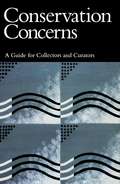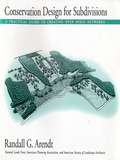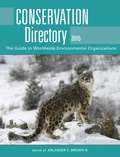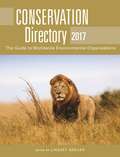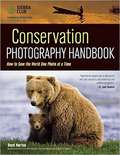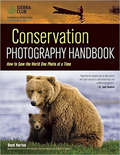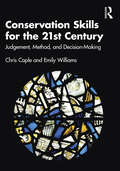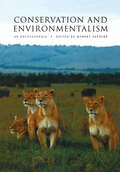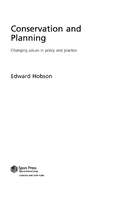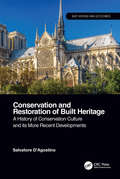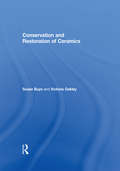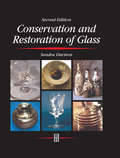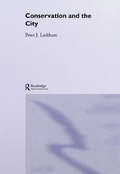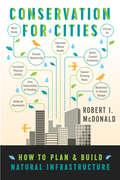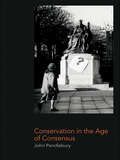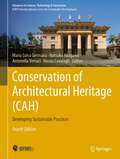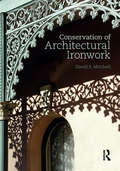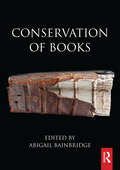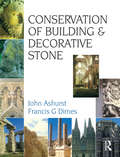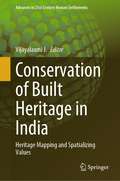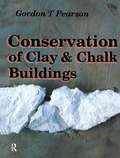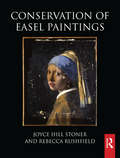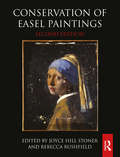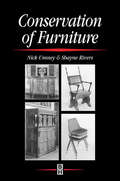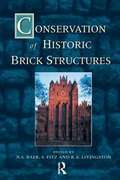- Table View
- List View
Conservation Concerns: A Guide for Collectors and Curators
by Konstanze BachmannWritten in accessible, nontechnical language, this book's twenty-three essays provide invaluable conservation guidelines for a variety of materials and media. Focusing also on proper storage techniques and environmental control, contributors offer information on emergency planning, disaster management, and identifying damages that may require professional treatment.From the Trade Paperback edition.
Conservation Design for Subdivisions: A Practical Guide To Creating Open Space Networks
by Randall G. ArendtIn most communities, land use regulations are based on a limited model that allows for only one end result: the production of more and more suburbia, composed of endless subdivisions and shopping centers, that ultimately covers every bit of countryside with "improvements." Fortunately, sensible alternatives to this approach do exist, and methods of developing land while at the same time conserving natural areas are available. In Conservation Design for Subdivisions, Randall G. Arendt explores better ways of designing new residential developments than we have typically seen in our communities. He presents a practical handbook for residential developers, site designers, local officials, and landowners that explains how to implement new ideas about land-use planning and environmental protection. Abundantly illustrated with site plans (many of them in color), floor plans, photographs, and renditions of houses and landscapes, it describes a series of simple and straightforward techniques that allows for land-conserving development. The author proposes a step-by-step approach to conserving natural areas by rearranging density on each development parcel as it is being planned so that only half (or less) of the buildable land is turned into houselots and streets. Homes are built in a less land-consumptive manner that allows the balance of property to be permanently protected and added to an interconnected network of green spaces and green corridors. Included in the volume are model zoning and subdivision ordinance provisions that can help citizens and local officials implement these innovative design ideas.
Conservation Directory 2015: The Guide to Worldwide Environmental Organizations
by Arlander C. BrownThe authority on natural resource use and management agencies around the world.Do you want to take action to protect Earth’s environment? Are you interested in learning more about wildlife conservation and environmental groups? The Conservation Directory 2015 is a great resource for budding environmental activists and scholars alike who want to achieve a peaceful, equitable, and sustainable future. This all-inclusive volume is an amazing resource that can help further these environmental goals.The new and revised 2015 edition of the Conservation Directory is the most comprehensive listing of conservation and environmental organizations yet published, with information on more than four thousand government agencies, nongovernmental organizations, and colleges and universities, as well as more than eighteen thousand officials concerned with environmental conservation, education, and natural resource use and management.Each entry contains detailed contact information, including names, addresses, and telephone numbers. Also included are selected email and Internet addresses, descriptions of program areas, senior staff by name and responsibility, principal publications, and more. Entries are categorized by organization and state or country and are indexed alphabetically and by subject on topics ranging from acid rain to zoology. Each person listed in the directory is also indexed alphabetically.
Conservation Directory 2017: The Guide to Worldwide Environmental Organizations
by Lindsey BreuerDo you want to take action to protect Earth’s environment? Are you interested in learning more about wildlife conservation and environmental groups? The Conservation Directory 2017 is a great resource for budding environmental activists and scholars alike who want to achieve a peaceful, equitable, and sustainable future. This all-inclusive volume is an amazing resource that can help further these environmental goals.The new and revised 2017 edition of the Conservation Directory is the most comprehensive listing of conservation and environmental organizations yet published, with information on more than four thousand government agencies, nongovernmental organizations, and colleges and universities, as well as more than eighteen thousand officials concerned with environmental conservation, education, and natural resource use and management.Each entry contains detailed contact information, including names, addresses, and telephone numbers. Also included are selected email and Internet addresses, descriptions of program areas, senior staff by name and responsibility, principal publications, and more. Entries are categorized by organization and state or country and are indexed alphabetically and by subject on topics ranging from acid rain to zoology. Each person listed in the directory is also indexed alphabetically.
Conservation Photography Handbook: How To Save The World One Photo At A Time
by Boyd NortonThis book is a call to action, providing the tools photographers need to help preserve threatened species and environments around the world or in their own backyards. Author/photographer Boyd Norton has spent over four decades successfully doing just that, and is credited with saving millions of wilderness acres through his photographs and personal activism. In this book, Norton shares his approaches to designing powerful images that communicate the threats facing wilderness areas, wildlife, and people around the world. His expert advice guides you step by step through the process of capturing effective photographs and implementing them to educate and build support for these critically important issues. Also featured are images and techniques from acclaimed conservation photographers Amy Gulick, Alexandra Garcia, Alison M. Jones, Joe Riis, Bob Rozinski, and Wendy Shattil.
Conservation Photography Handbook: How To Save The World One Photo At A Time
by Boyd NortonThis book is a call to action, providing the tools photographers need to help preserve threatened species and environments around the world or in their own backyards. Author/photographer Boyd Norton has spent over four decades successfully doing just that, and is credited with saving millions of wilderness acres through his photographs and personal activism. In this book, Norton shares his approaches to designing powerful images that communicate the threats facing wilderness areas, wildlife, and people around the world. His expert advice guides you step by step through the process of capturing effective photographs and implementing them to educate and build support for these critically important issues. Also featured are images and techniques from acclaimed conservation photographers Amy Gulick, Alexandra Garcia, Alison M. Jones, Joe Riis, Bob Rozinski, and Wendy Shattil.
Conservation Skills for the 21st Century: Judgement, Method, and Decision-Making
by Chris Caple Emily WilliamsConservation Skills for the 21st Century provides a much-needed update to the original Conservation Skills volume, presenting an overview of current issues facing conservators of historic and artistic works. Beginning with the basics – why the past is important, as well as an overview of the nature and history of conservation – the book allows the reader to develop a holistic appreciation of the subject. As with the first edition, this volume assists with the development of judgement in conservation students and young professionals. A selection of new case studies representing issues conservators are likely to face in the 21st century illustrates the crucial considerations that must be made when proposing and executing a conservation treatment. Incorporating recent developments and use of new technologies in conservation processes, the book also covers topics such as conservation ethics; recording and documentation; investigating and cleaning objects; stabilisation and restoration; values, decision-making, and responsibilities; preventive conservation; approaches to the treatment of working and socially active objects; sustainability in conservation; and the conservator’s role as advocate. With detailed case studies and written in a clear, accessible style, Conservation Skills for the 21st Century remains essential reading for student conservators and conservation professionals around the globe working across a wide range of conservation disciplines.
Conservation and Environmentalism: An Encyclopedia
by Robert PaehlkeFocusing on both problems and solutions, this authoritative reference work maintains a healthy balance between science and the social sciences in its coverage of all aspects of the environment. The book is arranged alphabetically and is divided into three major sections: Ecology, Pollution, and Sustainability. The list of 240 contributors reads like a who's who of the world's leading conservation and environmental professionals.Best Reference Source Outstanding Reference Source
Conservation and Planning: Changing Values in Policy and Practice
by Edward HobsonConserving historic buildings continues to excite and inflame opinion. The means of protecting such buildings and areas are well established but frequently suffer a lack of wider understanding. Conservation and Planning takes a detailed look at the way these processes have evolved and their use today by policy makers and local decision makers.This book presents original research into how national and local decision-makers construct and implement conservation of the built environment. The findings in this book challenge many of the assumptions supporting conservation.
Conservation and Restoration of Built Heritage: A History of Conservation Culture and its More Recent Developments (Built Heritage and Geotechnics)
by Salvatore D'AgostinoThe word conservation, when used in the context of the preservation of built heritage, implies an intrinsically complex concept that evolved over time, since it has been influenced by the perception of history throughout time. This volume emphasises why an understanding of the cultural evolution of the conservation approach must be considered a prerequisite for architects and engineers if they are to cooperate in full harmony with historic-artistic culture for the preservation of global built heritage. In particular, the volume highlights how, during the second half of the last century, the preservation process also involved engineering – the science of making practical applications of knowledge – which, for a long time, made an uncritical use of techniques and materials and devised interventions on historical heritage that were heavily invasive. The volume also devotes special attention to the problems related to seismic risk, to which Italy, Greece and Portugal are particularly prone. Problems that emerge during the crisis and reconstruction phases are dealt with in detail, as is scheduled maintenance, as this latter approach always constitutes an improvement in the performance of the monument and is the most appropriate tool for the conservation of the built heritage. Finally, the volume collects examples of building restoration with case studies of many outstanding monuments. The work will appeal to professionals and academics in the broader fields of civil engineering (both geotechnical and structural engineering), architecture, art history, the history of architecture, restoration and cultural heritage management. This book will: Provide a critical reading of the history of conservation; Discuss materials and techniques of ancient architecture; Cover seismic vulnerability and preservation of the historic integrity of the monument; Advocate an approach based on programmed maintenance; Feature numerous case histories, including St Mark’s Basilica in Venice and the complex restoration of the cathedral of Notre-Dame in Paris.
Conservation and Restoration of Ceramics (Butterworth-heinemann Series In Conservation And Museology Ser.)
by Susan Buys Victoria OakleyThe Conservation and Restoration of Ceramics brings together the wide range of current information relevant to the practising conservator. The book opens with a discussion of the fundamental nature of the ceramic medium, information which is of primary importance when selecting treatments or considering preventive conservation measures. Details on techniques are given in a series of chapters covering the restoration and conservation processes, but the emphasis is on the basic principles involved in the choice of materials and methods. The nature and properties of materials commonly in use are fully discussed and guidance is given on the facilities and equipment needed.Also covered in the book are old restoration materials and methods, the ethics of ceramics conservation, examination and recording, display treatments and emergency procedures.Now in paperback, this book will be invaluable to practising conservators and readers of conservation as well as of interest to museum curators and collectors.
Conservation and Restoration of Glass (Butterworth-heinemann Series In Conservation And Museology)
by Sandra Davison R.G. NewtonConservation and Restoration of Glass is an in-depth guide to the materials and practices required for the care and preservation of glass objects. It provides thorough coverage of both theoretical and practical aspects of glass conservation.This new edition of Newton and Davison's original book, Conservation of Glass, includes sections on the nature of glass, the historical development and technology of glassmaking, and the deterioration of glass. Professional conservators will welcome the inclusion of recommendations for examination and documentation. Incorporating treatment of both excavated glass and historic and decorative glass, the book provides the knowledge required by conservators and restorers and is invaluable for anyone with glass objects in their care.
Conservation and the City
by Peter LarkhamIt is a widely held belief that cities must change, or they will wither and die. One of the key problems of urbanization is how to cope with these changes while retaining the structures constructed and maintained by previous generations. Conservation and the City is a study of conservation and change throughout the built environment - city centres, suburbs and even tiny villages - and how the activites of conservation interact with the planning system. Using detailed case studies from Britain and the Westernized world, the author examines some of the key social, economic and psychological ideas which support conservation, as well as studying the urban landscape and the agents of change. Conservation and the City seeks to understand urban conservation, and in doing so presents possible solutions for managing change in the built environment of the future.
Conservation for Cities: How to Plan & Build Natural Infrastructure
by Robert I. McdonaldIt's time to think differently about cities and nature. Understanding how to better connect our cities with the benefits nature provides will be increasingly important as people migrate to cities and flourish in them. All this urban growth, along with challenges of adapting to climate change, will require a new approach to infrastructure if we're going to be successful. Yet guidance on how to plan and implement projects to protect or restore natural infrastructure is often hard to come by.With Conservation for Cities, Robert McDonald offers a comprehensive framework for maintaining and strengthening the supporting bonds between cities and nature through innovative infrastructure projects. After presenting a broad approach to incorporating natural infrastructure priorities into urban planning, he focuses each following chapter on a specific ecosystem service. He describes a wide variety of benefits, and helps practitioners answer fundamental questions: What are the best ecosystem services to enhance in a particular city or neighborhood? How might planners best combine green and grey infrastructure to solve problems facing a city? What are the regulatory and policy tools that can help fund and implement projects? Finally, McDonald explains how to develop a cost-effective mix of grey and green infrastructure and offers targeted advice on quantifying the benefits.Written by one of The Nature Conservancy's lead scientists on cities and natural infrastructure, Conservation for Cities is a book that ecologists, planners, and landscape architects will turn to again and again as they plan and implement a wide variety of projects.
Conservation in the Age of Consensus
by John PendleburyThis new text on the subject of conservation in the built environment provides a unique holistic view on the understanding of the practice of conservation connecting it with wider societal and political forces. UK practice is used as a means, along with international examples, for bringing together a real understanding of practice with a social science analysis of the issues. The author introduces ideas about the meanings and values attached to historic environments and how that translates into public policies of conservation.
Conservation of Architectural Heritage: Developing Sustainable Practices (Advances in Science, Technology & Innovation)
by Natsuko Akagawa Antonella Versaci Nicola Cavalagli Maria Luisa GermanàThis book presents practical, applicable solutions that contribute to built heritage conservation, discussing challenges like resource constraints, ineffective legislation, lack of coordination between different relevant bodies, and absence of public awareness and involvement. This is to maintain the beauty and cultural meaning of the architectural heritage since they are like a glimpse from the past life, representing how people lived, their religions, and beliefs in addition to the primitive but inspirational technology used in construction. As a result, this book is of significant importance to professionals in the fields of architecture, sustainability, as well as policymakers.
Conservation of Architectural Ironwork
by David S. MitchellThe peak of architectural ironwork in the 19th Century saw the spread of ornate decorative ironwork across the world. In recent years there has been a significant increase in conservation and restoration projects aiming to protect the artistry of traditional ironwork for future generations. Conservation of Architectural Ironwork is the first book to provide a complete guide to the conservation and maintenance of traditional architectural ironwork. First introducing the contextual history and key material features of architectural ironwork, the book goes on to guide readers through the management and delivery of conservation projects from start to finish, explaining the very latest in conservation technology. At its peak, architectural ironwork was used on a vast global scale in buildings, bridges, street furniture and ornamental structures. With international case studies and detailed illustrations, this book will be an essential reference for heritage professionals and students of architectural conservation around the world.
Conservation of Books (Routledge Series in Conservation and Museology)
by Abigail BainbridgeConservation of Books is the highly anticipated reference work on global book structures and their conservation, offering the first modern, comprehensive overview on this subject. The volume takes an international approach to its subject. Written by over 70 specialists in conservation and conservation science based in 19 countries, its 26 chapters cover traditional book structures from around the world, the materials from which they are made and how they degrade, and how to preserve and conserve them. It also examines the theoretical underpinnings of conservation: what and how to treat, and the ethical, cultural, and economic implications of treatment. Technical drawings and photographs illustrate the structures and treatments examined throughout the book. Ultimately, readers gain an in-depth understanding of the materiality of books in numerous global contexts and reflect on the practical considerations involved in their analysis and treatment. Conservation of Books is a quintessential reference work for book conservators and anyone working with books, such as collection managers, librarians, curators, dealers, collectors, historians, and related professionals. It is also an indispensable text for students to complement hands-on training in this field.
Conservation of Building and Decorative Stone (Butterworth-heinemann Series In Conservation And Museology)
by F G Dimes J. AshurstOne of the problems which beset the practical conservation of stone buildings is the fragmentation of the disciplines involved. This book, with both volumes now available as one invaluable paperback, brings these disciplines together by the involvement of contributors with different experiences and approaches to the same material. Part one is an introduction to the complexities and background history of stone conservation followed by the most comprehensive description yet produced of the building and decorative stones used in the British Isles.In part two, practitioners involved in stone conservation describe ways in which major structural masonry problems, secondary building problems and different stone surface conditions may be treated. A variety of building types and environments has been used to ensure that the broad scope of common problems is covered. This second part of the book will be of practical value to art historians, archaeologists, architects, surveyors and engineers, masonry contractors and sculpture conservators in solving problems and in learning to use each other's skills and experience.
Conservation of Built Heritage in India: Heritage Mapping and Spatializing Values (Advances in 21st Century Human Settlements)
by Vijayalaxmi J.This book focuses on the Heritage Conservation of Architecture, Historic Districts of a City and Conservation strategies with specific case studies from India, in order to highlight the need for conserving the rich piece of history through research, education, advocacy, and practice. The historic significance and the condition mapping of the subjects are carried out through primary field studies by the authors at School of Planning and Architecture, Vijayawada, India. The cases are analysed, and appropriate solutions and sustainable strategies are evolved for the conservation of the buildings facing contemporary challenges. The contents align with the Sustainable Development Goals (SDG 11), Target 11.4 which aims to “strengthen efforts to protect and safeguard the world's cultural and natural heritage'. This would ensure that a rich piece of history is documented and analysed to ensure that it is not erased and forgotten. This book serves as a bountiful data base of literature as well as conservation strategies for heritage conservationists, students of architectural conservation and researchers.
Conservation of Clay and Chalk Buildings
by Gordon T. PearsonThis publication provides practical guidance on appropriate methods of conservation and repair of earth buildings using traditional building materials. It is the first major work on the subject since Clough Williams-Ellis and the Eastwick-Fields published "Building in Cob, Pise and Stabilized Earth" in 1947. The book deals with the nature of clay and chalk, their qualities and characteristics, and the way in which they have been used to construct buildings. Advice is given on soils analysis, the philosophy of repair techniques and the factors to be considered before altering, converting or extending an earth building. The author primarily advocates repair techniques using traditional materials, but he also considers the role played by certain modern materials, and assesses their suitability.
Conservation of Easel Paintings (Routledge Series in Conservation and Museology)
by Joyce Hill Stoner Rebecca RushfieldConservation of Easel Paintings is the first comprehensive text on the history, philosophy, and methods of treatment of easel paintings that combines both theory with practice. With contributions from an international group of experts and interviews with important artists, this volume provides an all-encompassing guide to necessary background knowledge in technical art history, artists' materials, scientific methods of examination and documentation, with sections that present varying approaches and methods for treatment, including consolidation, lining, cleaning, retouching, and varnishing. The book concludes with a section featuring issues of preventive conservation, storage, shipping, exhibition, lighting, safety issues, and public outreach. Conservation of Easel Paintings is a crucial resource in the training of conservation students and will provide generations of practicing paintings conservators and interested art historians, curators, directors, collectors, dealers, artists, and students of art and art history with invaluable information and guidance.
Conservation of Easel Paintings (Routledge Series in Conservation and Museology)
by Stoner, Joyce Hill / Rushfield, RebeccaConservation of Easel Paintings, Second Edition provides a much-anticipated update to the previous edition, which has come to be known internationally as an invaluable and comprehensive text on the history, philosophy and methods of the treatment of easel paintings. Including 49 chapters written by more than 90 respected authors from around the world, this volume offers the necessary background knowledge in technical art history, artists’ materials and scientific methods of examination and documentation. Later sections of the book provide information about the varying approaches and methods for treatment and issues of preventive conservation, as well as valuable reflections on storage, shipping, and exhibition. Including exciting developments that have taken place since the last edition was published, the book also covers new techniques of examination, especially MacroXRF scanning and Reflectance Transmission Imagery. Drawing on research presented at recent professional conferences, information about innovative methods for cleaning modern and contemporary paintings and insights into modern oil paints is also included. Incorporating the latest regulations and understanding of health and safety practices and integrating theory with practice throughout, Conservation of Easel Paintings, Second Edition will continue to be an indispensable reference for practicing conservators. It will also be an essential resource for students taking conservation courses around the world.
Conservation of Furniture (Routledge Series In Conservation And Museology Ser.)
by Shayne Rivers Nick UmneyThis book is a comprehensive resource covering the principles and practice of the conservation and restoration of furniture, and other decorative art objects made wholly or partly of wood. It integrates theory with practice to show the principles which govern interaction between wooden objects, the environmental and conservation treatments and the factors which need to be taken into account to arrive at acceptable solutions to conservation problems.The practical knowledge and experience of a team of conservators active in the field are bought together with theoretical and reference material from diverse sources and unified within a systematic framework. Specialist conservators from related disciplines cover diverse materials often incorporated into furniture.
Conservation of Historic Brick Structures
by Norbert Baer Fitz LivingstoneDespite the widespread use of brick construction throughout the world, there has been no major investigation into its deterioration and durability. This book provides the results of a major international study led by West Germany which examines the causes of decay in addition to the treatment and methods of conserving brickwork and historic mortars. The deterioration mechanisms discussed cover bio deterioration, salt damage and the effects of air pollutants and moisture on masonry. Considerable attention is also devoted to historic mortars and renders, their analysis, behaviour under the stress of air pollution and the development of compatible modern formulations. Conservation methods for brick masonry, including de-salination, protective coatings and injection grouting are examined in detail. A useful and extensive range of case study material is also provided. This volume represents the most comprehensive, state of the art overview of the conservation of historic brick masonry, and will be an invaluable source of reference for all conservation practitioners and researchers working in this field.
